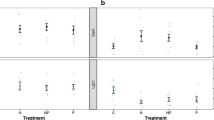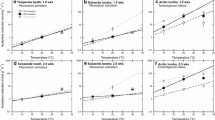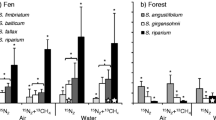Abstract
Nitrogen fixation by cyanobacteria in a moss community on East Ongul Island (69°00'S 39°35'E), Antarctica was investigated using the acetylene reduction method.
The mean acetylene reduction rate at 10°C and 200 μE·m−2·s−1 photosynthetically active radiation was 7.12 nmol C2H4 per square centimeter of moss community per hour. The effects of temperature, radiation, desiccation and rehydration on the acetylene reduction rates were examined.
A simple predictive model was constructed in order to estimate the amount of nitrogen fixed in the field. Using this model, the daily amount of nitrogen fixation was calculated from microclimatic data (temperature and radiation) measured in the experimental field at Syowa Station on East Ongul Island between 1983 and 1984. The cumulative amount of nitrogen fixation in the growing season during this period was estimated to be 329 mg N per square meter of moss community.
It is suggested that nitrogen fixation by cyanobacteria in the moss community is important as a nitrogen source for the community growth on East Ongul Island.
Similar content being viewed by others
References
Alexander, V. &Schell, D. M. (1973) Seasonal and spatial variation of nitrogen fixation in the Barrow, Alaska, tundra. Arct. Alp. Res.5: 77–78.
— (1978) Nitrogen fixation in arctic and alpine tundra. “Vegetation and Production Ecology of an Alaskan Arctic Tundra” Ecological Studies 29 (ed. Tieszen, L. L.), 539–558, Springer, Berlin.
Basilier, K. (1980) Fixation and uptake of nitrogen inSphagnum blue-green algal associations. Oikos34: 239–242.
— (1978) Nitrogen fixation in wet minerotrophic moss communities of a subarctic mice. Oikos31: 236–246.
Bergersen, F. J. (1970) The quantitative relationship between nitrogen fixation and the acetylenereduction assay, Aust. J. biol. Sci.23: 1015–1025.
Davey, A. (1983) Effects of abiotic factors on nitrogen fixation by blue-green algae in Antarctica. Polar Biol.2: 95–100.
— (1983) Seasonal variation in nitrogen fixation byNostoc commune Vaucher at the Vestfold Hills, Antarctica. Phycologia22: 377–385.
Davis, R. C. (1981) Structure and function of two Antarctic terrestrial moss communities. Ecol. Mongr.51: 125–143.
Fogg, G. E. &Stewart, W. D. P. (1968)In situ determinations of biological nitrogen fixation in Antarctica. Br. Antarct. Surv. Bull.15: 39–46.
Fukushima, H. (1959) General report on fauna and flora of the Ongul Islands, Antarctica, especially on freshwater algae. J. Yokohama Munic. Univ., Ser. C112: 1–10 (In Japanese with English summary).
Ino, Y. (1983) Estimation of primary production in moss community on East Ongul Island, Antarctica. Nankyoku Shiryo (Antarct. Rec.)80: 30–38.
— (1980) Soil respiration in the vicinity of Syowa Station, Antarctica. 1. Relationships between soil respiration rate and water content or nitrogen content. Nankyoku Shiryo (Antarct. Rec.)70: 31–39.
— (1986) Distribution of carbon, nitrogen and phosphorus in a moss community-soil system developed on a cold desert in Antarctica. Ecol. Res.1: 59–69.
Jones K. &Wilson, R. E. (1978) The fate of nitrogen fixed by a free-living blue-green alga. “Environmental Role of Nitrogen-fixing blue-green Algae and Asymbiotic Bacteria” Ecol. Bull. 26 (ed. Granhall, U.), 158–163. Swedish Natural Science Research Council. Stockholm.
Kanda, H. (1981) Flora and vegetation of mosses in ice-free areas of Soya Coast and Prince Olav Coast, East Antarctica. Hikobia Suppl.1: 91–100.
— (1986) Seasonal changes of some environmental factors around the moss vegetation near Syowa Station, East Antarctica. Mem. Nat. Inst. Polar Res. Ser. E37: 17–26.
Matsuda, T. (1968) Ecological study of the moss community and microorganisms in the vicinity of Syowa Station, Antarctica. JARE Sci. Rep. Ser E (Biol. Med. Sci.)29: 58 pp.
Nakanishi, S. (1977) Ecological studies of the moss and lichen communities in the ice-free areas near Syowa Station, Antarctica. Nankyoku Shiryo (Antarct. Rec.)59: 68–96.
Nakatsubo, T. &Ino, Y. (1986) Nitrogen cycling in an Antarctic ecosystem. 1. Biological nitrogen fixation in the vicinity of Syowa Station. Mem. Nat. Inst. Polar Res. Ser. E37: 1–10.
Smith, V. R. (1977) A qualitative description of energy flow and nutrient cycling in the Marion Island terrestrial ecosystem. Polar Record18:361–370.
—. (1978) Plant ecology of Marion Island: a review. S. Afr. J. Antarct. Res.8: 21–30.
—. (1984) Effects of abiotic factors on acetylene reduction by cyanobacteria epiphytic on moss at a subantarctic island. Appl. Environ. Microbiol.48: 594–600.
Stewart, W. D. P. (1963) Liberation of extracellular nitrogen by two nitrogen-fixing blue-green algae. Nature200: 1020–1021.
— (1967)In situ studies on N2 fixation using the acetylene reduction technique. Proc. Natl. Acad. Sci USA58: 2071–2078.
Stutz, R. C. &Bliss, L. C. (1975) Nitrogen fixation in soils of Truelove Lowland, Devon Island, Northwest Territories. Can. J. Bot.53: 1387–1399.
Turpin, D. H. &Layzell, D. B. (1985) A culture system enablingin situ determination of net and gross photosynthesis, O2 evolution, N assimilation, and C2H2 reduction in cyanobacteria. Can. J. Bot.63: 1025–1030.
Yamanaka, M. &Sato, K. (1977) Distribution of terrestrial plant communities near Syowa Station in Antarctica, with special reference to water supply and soil property. Nankyoku Shiryo (Antarct. Rec.)59: 54–67 (In Japanese with English summary).
Author information
Authors and Affiliations
About this article
Cite this article
Nakatsubo, T., Ino, Y. Nitrogen cycling in an Antarctic ecosystem 2. Estimation of the amount of nitrogen fixation in a moss community on East Ongul Island. Ecol. Res. 2, 31–40 (1987). https://doi.org/10.1007/BF02348617
Accepted:
Issue Date:
DOI: https://doi.org/10.1007/BF02348617




